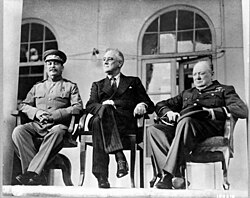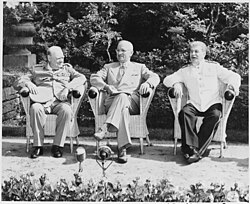1940

April
- 3 April 1940: The Ministerial Defence Committee, with the First Lord of the Admiralty (Winston Churchill) as its chair, replaces Lord Chatfield's ministerial position of Minister for Coordination of Defence.
May
- 10 May 1940: Germany invades Belgium, France, Luxembourg and the Netherlands.
Following the Norway Debate, Winston Churchill becomes Prime Minister of the United Kingdom upon the resignation of Neville Chamberlain.
The United Kingdom invades Iceland.
Belgium declares a state of emergency.
Churchill is called on to form a wartime coalition government. [2] - 11 May 1940: Churchill offers the former Kaiser Wilhelm II, who is now living in the Netherlands, asylum in the United Kingdom; he declines.
- 13 May 1940: Dutch government-in-exile established in London.
Queen Wilhelmina of the Netherlands flees to asylum in the United Kingdom.
Churchill's "blood, toil, tears, and sweat" speech in Commons. - 14 May 1940: The creation of the Local Defence Volunteers (the Home Guard) is announced by the new Secretary of State for War Anthony Eden. It is mostly composed of the elderly and retired.
Churchill asks President Roosevelt and Canada for aid in these dark days. Outlines of the new British coalition, which includes Labour, Liberal, and Conservative members, is made public. - 16 May 1940: Churchill visits Paris and hears that the French war is as good as over.
- 30 May 1940: Crucial British Cabinet meeting: Churchill wins a vote on continuing the war, in spite of vigorous arguments by Lord Halifax and Chamberlain.
June
- 4 June 1940: Churchill's "We shall fight on the beaches" speech to the House of Commons.
- 18 June 1940: Churchill gives his famous "finest hour" speech to the House of Commons.
August
- 20 August 1940: Italy announces a blockade of British ports in the Mediterranean area.
- 20 August 1940: Churchill's speech "Never was so much owed by so many to so few" delivered to the House of Commons.
- 25 August 1940: Churchill orders the bombing of Berlin in retaliation for the previous night's bombing of Cripplegate.
October
- 9 October 1940: Neville Chamberlain resigns from the House of Commons for health reasons; Winston Churchill is elected head of the Conservative Party.
November
- 16 November 1940: Churchill orders some British troops in North Africa to be sent to Greece, despite concerns by his military.






